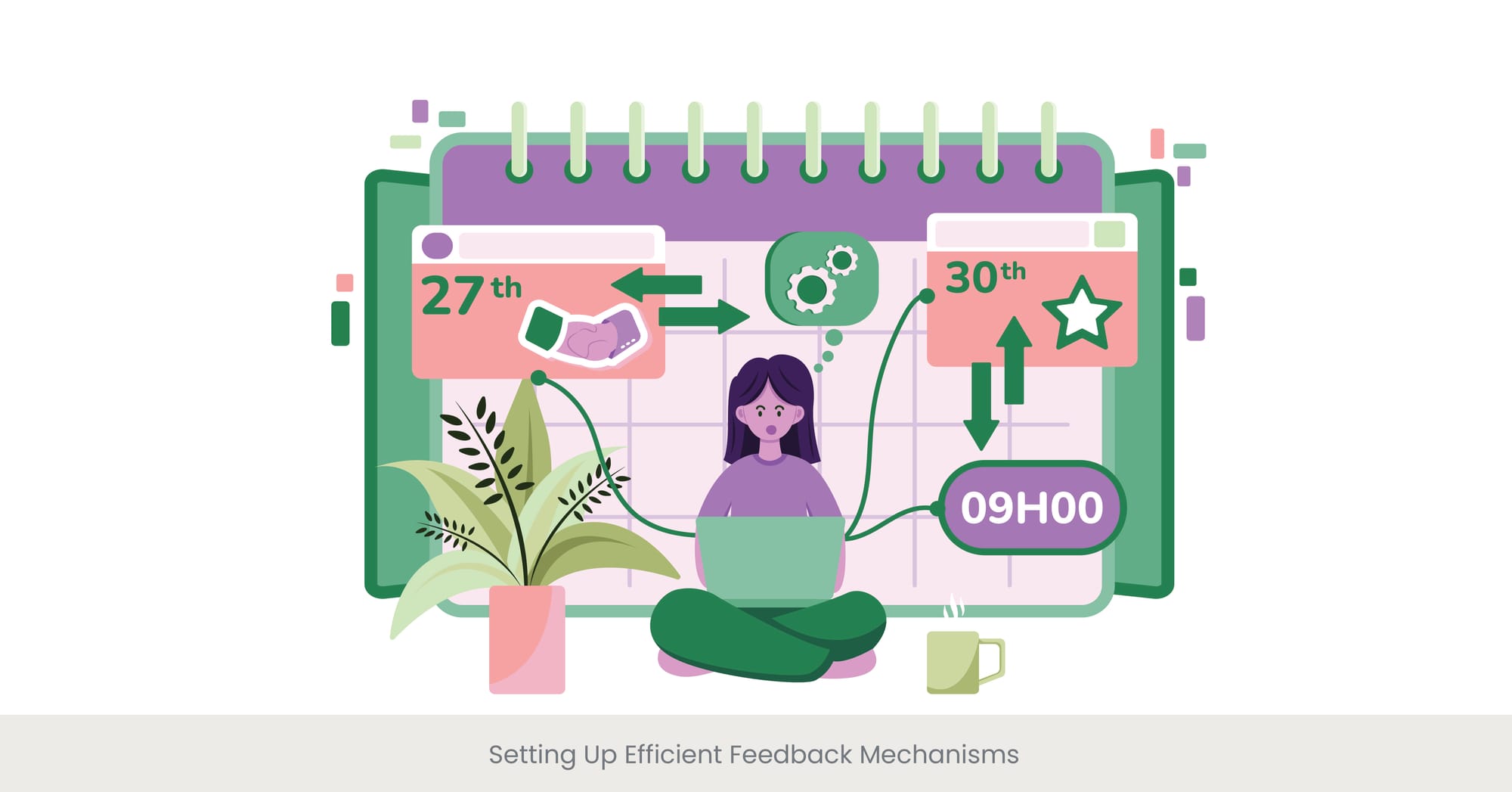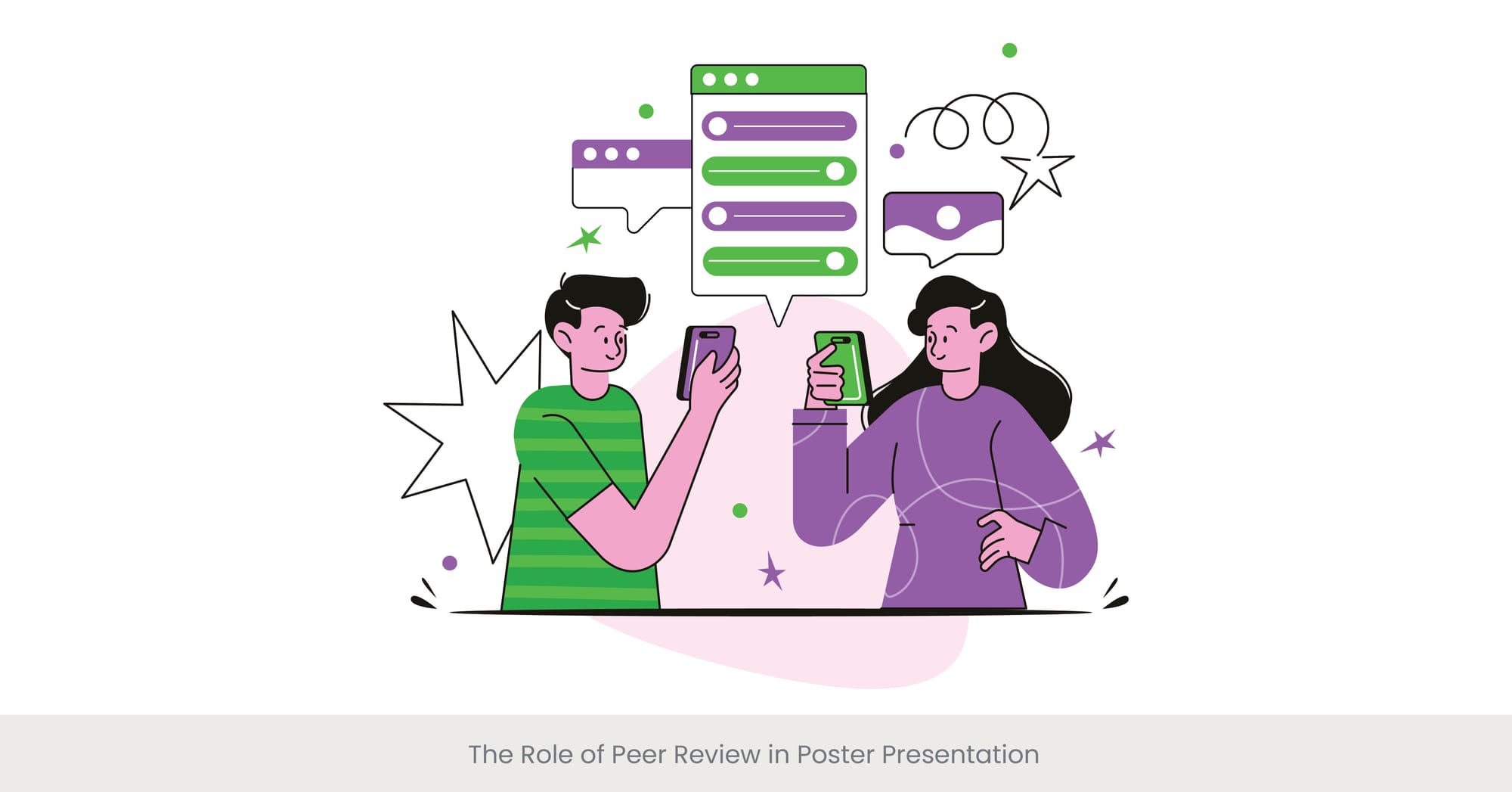
Setting Up Efficient Feedback Mechanisms

Introduction: Foundation of Constructive Feedback
Establishing efficient mechanisms for collecting feedback is crucial for anyone looking to improve their performance, whether in academic poster presentations or conference presentation settings. Effective feedback systems not only gather critical insights but also streamline the process of integrating this important information back into practical applications. For those participating in poster sessions, having a reliable feedback technique in place is essential to improving future presentations.
Background: Evolution of Feedback Collection
Feedback mechanisms have evolved from traditional face-to-face interactions to incorporate a variety of digital tools that facilitate immediate and widespread feedback. This evolution reflects a broader trend in data-driven decision-making, where real-time feedback is used to enhance outcomes across different domains, from academic poster presentations to poster presentation coaching in the business sector.
Real-World Applications and Case Studies
For instance, at a major academic conference, organizers implemented a digital feedback system using QR codes placed on each poster. Attendees could scan the code to submit feedback directly from their mobile devices, allowing presenters to receive immediate and actionable insights. This method proved to be highly efficient, significantly increasing the quantity and quality of feedback received.
Expert Opinions and Best Practices
Experts suggest that the key to setting up an efficient feedback mechanism lies in its accessibility and relevance. Tools like online surveys, mobile apps, and interactive kiosks can be highly effective if they are user-friendly and tailored to the specific needs of the audience. Incorporating these tools during poster presentation coaching can help presenters refine their approach and improve audience engagement. According to a study published in "Journal of Effective Communication," incorporating simple graphics, clear questions, and ensuring anonymity can greatly increase participation rates and the honesty of the responses.
Interpreting Feedback for Future Improvements

Introduction: The Art of Feedback Interpretation
Interpreting feedback effectively is essential for leveraging insights to drive future improvements. This process involves not only understanding the content and format of the feedback but also analyzing the underlying implications. For example, after receiving feedback on an academic poster presentation, a presenter can use those insights to enhance future conference presentations and better engage audiences in poster sessions.
Background: Importance of Nuanced Interpretation
Feedback interpretation has become a critical skill in both personal development and organizational growth. For those involved in poster presentation coaching, it's essential to discern patterns and emotional intelligence to understand the context behind the feedback. This nuanced approach ensures that actions taken are constructive and aligned with audience needs.
Real-World Examples and Success Stories
In academic research, a university department utilized structured feedback from students to overhaul their curriculum. Similarly, feedback techniques used in poster sessions can help identify areas of improvement. By analyzing audience suggestions and peer reviews, presenters can refine their content and conference presentation style, making future sessions more impactful.
Expert Recommendations and Methodologies
Experts recommend using both qualitative and quantitative methods to interpret feedback. Tools like sentiment analysis software can help quantify emotions in large datasets, while thematic analysis can uncover deeper insights in qualitative feedback. This approach is particularly useful in poster presentation coaching, where understanding the needs and preferences of the audience is key to engaging your audience in poster sessions effectively.
Incorporating Audience Suggestions into Your Research

Introduction: Valuing Audience Input
Incorporating audience suggestions into research not only enhances the relevance and impact of research findings but also fosters a collaborative relationship between the researcher and the audience. For researchers presenting at conference presentations and poster sessions, this practice is crucial for staying attuned to the needs of their field.
Background: Collaborative Research Dynamics
Engaging with your audience and integrating their feedback has become a cornerstone of modern research practices. This approach ensures that research remains user-centered, addressing real-world problems and adapting to new discoveries and societal changes. It encourages a dynamic exchange of ideas, where both researchers and participants contribute to the evolution of the study.
Real-World Examples of Successful Integration
A notable example involves a public health study where researchers adjusted their investigation methods based on community feedback. For academic presenters, this same principle applies during poster presentation coaching—feedback gathered from peers and the audience can lead to improvements in conference presentations, helping them engage audiences in poster sessions more effectively.
Expert Opinions and Best Practices
Experts suggest several strategies for effectively incorporating audience suggestions, such as holding focus groups or using digital platforms for continuous feedback collection. For presenters, integrating feedback during poster sessions is essential. Structured channels for feedback ensure that all suggestions are considered systematically and transparently. Additionally, acknowledging contributors can help maintain a positive relationship and foster a sense of collaboration, key to poster presentation coaching and engagement.
The Role of Peer Review in Poster Presentation

Introduction: Enhancing Quality Through Peer Review
Peer review plays a critical role in maintaining the quality and integrity of academic poster presentations, particularly in conference presentations. This evaluative process helps to ensure that the information presented is accurate, relevant, and up-to-date, enhancing the overall engagement and credibility of the work.
Background: Foundations of Peer Review
The practice of peer review has been a fundamental part of scholarly communication for centuries, serving as a checkpoint for the validation of methodologies and findings. In the context of poster presentation coaching, peer review is particularly important for refining content before poster sessions, allowing presenters to receive critical feedback on clarity, accuracy, and presentation style.
Real-World Impact of Peer Review
An example of the effective use of peer review can be seen in a recent environmental science conference where all submitted posters underwent a rigorous review process. This not only improved the overall quality of the academic poster presentations but also led to deeper engagement during the poster sessions, as participants discussed the feedback they received.
Expert Insights and Practical Guidance
Experts recommend structuring the peer review process to be as constructive as possible, focusing on enhancing the presenter's work rather than merely critiquing it. Best practices include using a full format or standardized review form that addresses specific aspects of the presentation, such as clarity, accuracy, and relevance. For presenters preparing for conference presentations, peer review feedback can be instrumental in refining their content and improving how they engage audiences in poster sessions.
Online Tools and Platforms for Collecting Feedback

Introduction: Leveraging Technology for Feedback Collection
In today’s digital age, feedback collection tools and online platforms are essential for efficiently gathering and managing feedback. These technologies offer scalable, accessible, and versatile solutions that can significantly enhance the feedback process for both researchers and presenters.
Background: The Digital Shift in Feedback Collection
The transition to using feedback collection tools has been driven by the need for more dynamic and interactive engagement strategies. Online platforms can facilitate real-time feedback, broader reach, and deeper analytics compared to traditional methods. This shift not only streamlines the collection process but also provides richer data for analysis.
Examples of Effective Tools and Their Impact
Platforms like SurveyMonkey, Google Forms, and Slido are some of the most effective feedback collection tools due to their user-friendly interfaces and comprehensive features, such as customizable surveys and live polling. For example, during a major educational conference, Slido was used to gather real-time feedback, allowing presenters to adjust their content on the fly based on immediate audience reactions.
Expert Recommendations and Best Practices
Experts in digital communication recommend selecting feedback collection tools that integrate seamlessly with other research and presentation platforms. It’s also important to choose tools that prioritize data privacy and security. In the digital feedback landscape, "Digital Feedback in Modern Research" emphasizes selecting platforms that offer both qualitative and quantitative feedback options to provide a comprehensive analysis.
Reach out to us for expert feedback collection tools.
Constructive Criticism: How to Give and Receive

Introduction: The Art of Constructive Criticism
Delivering constructive criticism effectively is crucial for promoting growth and improvement. The key is to offer feedback that is both actionable and encouraging, helping individuals or teams to enhance their performance without feeling demotivated.
Background: The Dynamics of Effective Feedback
The foundation of constructive criticism tips lies in clarity, respect, and positivity. Successful feedback creates an environment where individuals feel valued and are open to receiving advice. Historically, when feedback is delivered with respect and specificity, it leads to meaningful change and improvement.
Real-World Applications and Success Stories
In a corporate setting, a manager implemented structured feedback sessions based on constructive criticism tips, focusing on specific behaviors rather than personal traits. This led to enhanced team performance, as employees felt the feedback was aimed at helping them grow.
Expert Advice and Recommendations
Experts recommend framing constructive criticism around specific, actionable points. "Navigating Constructive Criticism" suggests presenting feedback in a way that encourages dialogue, allowing recipients to ask questions or express concerns. This open discussion strengthens the effectiveness of feedback.
Explore INK PPT’s case studies for innovative feedback solutions.
Using Feedback to Enhance Personal Growth

Introduction: The Transformative Power of Feedback
Embracing feedback as a tool for personal growth is essential. When combined with constructive criticism tips, feedback becomes a powerful means for developing resilience and self-awareness, crucial traits for personal and professional development.
Background: Psychological and Educational Perspectives on Feedback
Psychologically, feedback serves as a critical element in the self-regulation process. Educational theories also underscore the importance of reflective practice, where individuals incorporate constructive criticism tips to inform future actions and decisions.
Real-World Examples of Feedback Driving Personal Growth
In the context of a professional development program, participants who actively sought out and reflected on feedback showed significant improvements in leadership skills and emotional intelligence. These individuals were better able to assess their strengths and weaknesses, set realistic goals, and improve their interpersonal relationships within teams.
Expert Insights and Practical Applications
Experts in psychology and human development suggest that for feedback to be effective in fostering personal growth, it must be constructive and aligned with clear goals. "Growth Through Feedback," a notable publication in the field, recommends establishing a regular practice of seeking feedback, reflecting on it thoughtfully, and setting specific, measurable goals for personal development. This practice should be coupled with an openness to change and a supportive environment that encourages risk-taking and learning from mistakes.
Long-term Tracking of Feedback Trends

Introduction: The Strategic Value of Tracking Feedback Over Time
The long-term tracking of feedback trends is crucial for continuous improvement. By monitoring feedback over an extended period, organizations can identify patterns and make informed decisions to drive sustained success.
Background: Evolution of Feedback Analysis
Historically, tracking feedback trends was a complex process. Today, advancements in data analytics allow for precise and efficient tracking, making it easier for organizations to analyze large datasets and derive actionable insights.
Real-World Impact of Feedback Trend Analysis
For example, a university used tracking feedback trends to gather student feedback over multiple semesters. This analysis revealed a demand for more interactive teaching methods, leading to curriculum changes that improved overall student satisfaction.
Expert Recommendations and Technological Insights
Experts recommend using software platforms designed for tracking feedback trends to automate the process and ensure consistent data analysis. Tools that offer longitudinal analysis features are essential for identifying feedback trends and adjusting strategies accordingly.
Feedback Loops: Continuous Improvement Process

Introduction: The Cycle of Feedback and Improvement
The continuous improvement process relies heavily on feedback loops, where action is followed by feedback collection and response. This iterative approach helps individuals and organizations make timely adjustments for sustained success.
Background: The Mechanics of Feedback Loops
The continuous improvement process hinges on the effectiveness of feedback loops, which consist of three key stages: action, feedback, and adjustment. By consistently following this cycle, individuals and teams can continuously refine their practices.
Real-World Examples of Effective Feedback Loops
In a healthcare setting, a hospital applied the continuous improvement process by implementing feedback loops in its patient care protocols. This led to iterative changes that significantly enhanced patient outcomes.
Expert Insights and Implementation Strategies
Experts recommend using technology to automate the feedback loop within the continuous improvement process. By doing so, organizations can ensure fast responses to feedback and foster a culture that values continuous growth and adaptability.
Read our comprehensive guide to mastering feedback loops.
Sharing Revised Posters Based on Feedback

Introduction: The Cycle of Revision and Sharing
In academic and professional settings, revising and sharing updated materials based on feedback is crucial. Incorporating revised poster presentation techniques ensures that your materials are accurate, clear, and impactful.
Background: Importance of Revisions in Academic and Professional Settings
The practice of revised poster presentation is rooted in the scientific method, where continuous improvement and peer validation are emphasized. By revising research posters based on audience feedback, presenters demonstrate their commitment to excellence.
Real-World Application of Feedback-Driven Revisions
At a recent international science conference, a research team implemented a revised poster presentation strategy after receiving feedback on their original design. Their revised version, which featured clearer data visualizations and more concise language, was well-received for its improved clarity.
Expert Recommendations and Best Practices
Experts recommend using digital platforms to share revised poster presentations and gather additional feedback. This iterative approach, which involves continuously revising and sharing improved versions of the presentation, helps maintain accuracy and engagement over time.
Ready to enhance your feedback collection methods?
Frequently Asked Questions
1. How do you collect and analyze feedback?
To collect and analyze feedback effectively, use a combination of surveys, interviews, and digital analytics tools. Ensure that your questions are clear and targeted to gather specific insights. For analysis, categorize feedback into themes and use quantitative tools to identify trends and patterns.
2. Why is it important to gather feedback?
Gathering feedback is crucial for understanding the impact of your work, identifying areas for improvement, and ensuring that your project or service meets the needs and expectations of your audience. It also helps in making informed decisions and fostering continuous improvement.
3. What is a formal method of collecting feedback?
Formal methods of collecting feedback include structured surveys, feedback forms, and scheduled review meetings. These methods provide systematic and consistent data that can be easily analyzed for insights.
4. What is obtaining feedback?
Obtaining feedback involves actively seeking out opinions, reactions, and suggestions from others regarding your work or performance. It can be done through various channels like direct communication, surveys, or observation of behavior and engagement.
5. How do you interpret feedback?
Interpret feedback by looking for common themes, assessing the severity of issues raised, and considering the context in which the feedback was given. It's important to differentiate between subjective opinions and objective criticisms that are actionable.
6. How do you analyze and create feedback?
Analyze feedback by compiling it into manageable categories, using statistical tools to identify trends, and applying analytical frameworks to understand and explain the underlying messages. Consider both qualitative and quantitative data for a comprehensive view.
7. How to quantify feedback?
To quantify feedback, convert qualitative data into quantitative forms using scales (e.g., rating scales from 1-5), make charts to count frequencies of specific comments or issues, and use software tools to perform sentiment analysis.
8. How best to collate feedback comments?
Collate feedback comments by organizing them into thematic categories or according to the questions they address. Use software tools to help sort and analyze comments efficiently, ensuring that no critical insights are overlooked.
9. What is a good reach to engagement ratio?
A good reach to engagement ratio depends on the context and goals of your project. Generally, a higher ratio indicates that a larger portion of your audience is actively interacting with your content, suggesting effective engagement.
10. What is the difference between reach and engagement metrics?
Reach metrics quantify how many people have seen or could see your content, while engagement metrics measure how people are interacting with it, such as likes, comments, shares, or time spent on a page. Both provide insights into the effectiveness of your communication.



%20(1).jpg)
%20(1).jpg)


